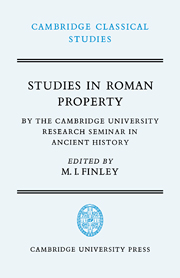Book contents
- Frontmatter
- Contents
- Preface
- 1 INTRODUCTION
- 2 SOME CONFIGURATIONS OF LANDHOLDING IN THE ROMAN EMPIRE
- 3 IMPERIAL ESTATES
- 4 CLASSICAL ROMAN LAW AND THE SALE OF LAND
- 5 THE CICERONIAN ARISTOCRACY AND ITS PROPERTIES
- 6 PRIVATE FARM TENANCY IN ITALY BEFORE DIOCLETIAN
- 7 URBAN PROPERTY INVESTMENT
- 8 AGRI DESERTI
- Notes
- Bibliography
- Index
6 - PRIVATE FARM TENANCY IN ITALY BEFORE DIOCLETIAN
Published online by Cambridge University Press: 05 June 2014
- Frontmatter
- Contents
- Preface
- 1 INTRODUCTION
- 2 SOME CONFIGURATIONS OF LANDHOLDING IN THE ROMAN EMPIRE
- 3 IMPERIAL ESTATES
- 4 CLASSICAL ROMAN LAW AND THE SALE OF LAND
- 5 THE CICERONIAN ARISTOCRACY AND ITS PROPERTIES
- 6 PRIVATE FARM TENANCY IN ITALY BEFORE DIOCLETIAN
- 7 URBAN PROPERTY INVESTMENT
- 8 AGRI DESERTI
- Notes
- Bibliography
- Index
Summary
The delimitation of subject expressed in the title requires comment. There were many tenants on public land as well, some under legal and economic conditions comparable to those of tenants on private holdings. But the public hand introduced an additional element, at least de facto, that can only confuse the discussion, and on many imperial estates (which are examined in an earlier chapter) there were tenancy arrangements for which private parallels are unattested and, in the nature of the case, impossible. The most obvious example is the ‘Mancian tenure’ in North Africa, which, as it happens, constitutes the bulk of what we know today about tenancy on imperial estates, apart from Egypt. My concern is with one of the two ways that Roman owners of large landholdings exploited them – the other was of course ‘direct’ exploitation by slaves under a vilicus – and that can be studied only by exclusive concentration on private owners.
Restriction to Italy has a double explanation. First, the conditions and the rules in various parts of the empire differed greatly, chiefly because the Roman conquerors did not normally overthrow existing institutions, so that Roman Egypt, for example, was in this respect more like Ptolemaic, or even Pharaonic, Egypt than like Italy. Egypt provides by far the fullest and most detailed documentation, but for extremely short leases, one to three years, within a legal system which, however one chooses to label it, was not Roman, and within an inexorable irrigation system wholly alien to Italian, or European, experience.
- Type
- Chapter
- Information
- Studies in Roman PropertyBy the Cambridge University Research Seminar in Ancient History, pp. 103 - 122Publisher: Cambridge University PressPrint publication year: 1976
- 15
- Cited by



